Discover 50 hidden attractions, cool sights, and unusual things to do in Mexico. Don't miss out on these must-see attractions: El Castillo (Chichen Itza), Museo Nacional de Antropología (Mexico City) or Chapultepec Castle (Mexico City).
Below, you can find the list of the most amazing places you should visit in Mexico.
Table of Contents
El Castillo, Chichen Itza
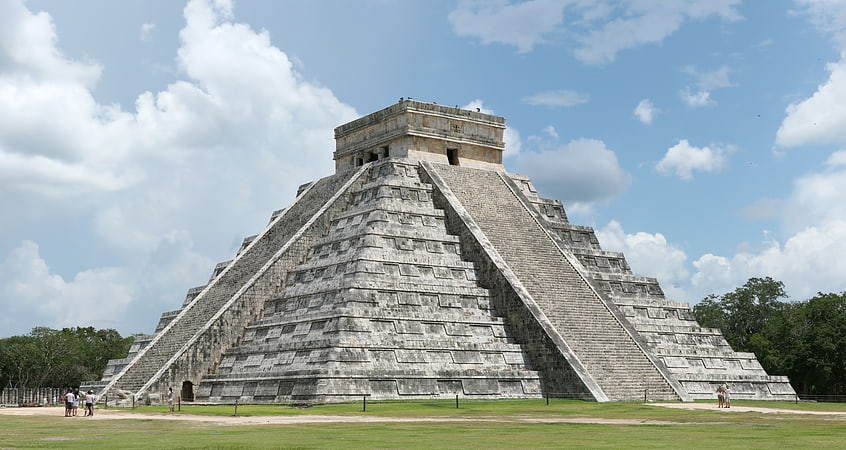
Also known as: Templo de Kukulkán
Maya temple in the shape of a pyramid. La Pirámide, known as the Temple of Kukulcán, is a Mesoamerican step-pyramid that dominates the center of the Chichen Itza archaeological site in the Mexican state of Yucatán. The pyramid building is more formally designated by archaeologists as Chichen Itza Structure 5B18.
Built by the pre-Columbian Maya civilization sometime between the 8th and 12th centuries AD, the pyramid served as a temple to the deity Kukulcán, the Yucatec Maya Feathered Serpent deity closely related to Quetzalcoatl, a deity known to the Aztecs and other central Mexican cultures of the Postclassic period. It has a substructure that likely was constructed several centuries earlier for the same purpose.
The pyramid consists of a series of square terraces with stairways up each of the four sides to the temple on top. Sculptures of plumed serpents run down the sides of the northern balustrade. Around the spring and autumn equinoxes, the late afternoon sun strikes off the northwest corner of the pyramid and casts a series of triangular shadows against the northwest balustrade, creating the illusion of the feathered serpent "crawling" down the pyramid. To contemporary visitors, the event has been very popular and is witnessed by thousands at the spring equinox, but it is not known whether the phenomenon is a result of a purposeful design since the light-and-shadow effect can be observed without major changes during several weeks near the equinoxes.
Scientific research led since 1998 suggests that the pyramid mimics the chirping sound of the quetzal bird when humans clap their hands around it. The researchers argue that this phenomenon is not accidental, that the builders of this pyramid felt divinely rewarded by the echoing effect of this structure. Technically, the clapping noise rings out and scatters against the temple's high and narrow limestone steps, producing a chirp-like tone that declines in frequency.
All four sides of the pyramid have approximately 91 steps which, when added together and including the temple platform on top as the final "step", may produce a total of 365 steps (the steps on the south side of the pyramid are eroded). That number is equal to the number of days of the Haab' year and likely is significantly related to rituals.
The structure is 24 m (79 ft) high, plus an additional 6 m (20 ft) for the temple at the top. The square base measures 55.3 m (181 ft) across.[1]
Address: Chichen Itza, 97751 Chichen Itza
Museo Nacional de Antropología, Mexico City
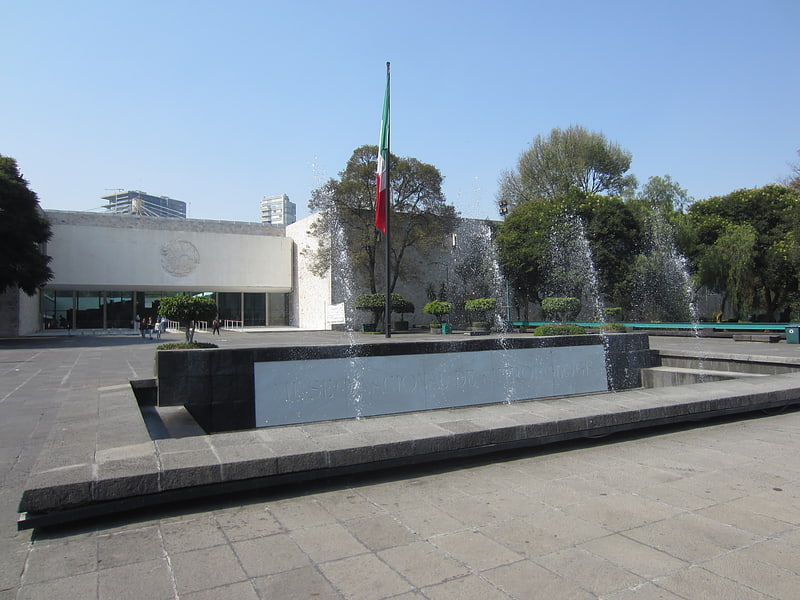
Museum with Mayan artifacts . The National Museum of Anthropology is a national museum of Mexico. It is the largest and most visited museum in Mexico. Located in the area between Paseo de la Reforma and Mahatma Gandhi Street within Chapultepec Park in Mexico City, the museum contains significant archaeological and anthropological artifacts from Mexico's pre-Columbian heritage, such as the Stone of the Sun and the Aztec Xochipilli statue.
The museum (along with many other Mexican national and regional museums) is managed by the Instituto Nacional de Antropología e Historia (National Institute of Anthropology and History), or INAH. It was one of several museums opened by Mexican President Adolfo López Mateos in 1964.
Assessments of the museum vary, with one considering it "a national treasure and a symbol of identity. The museum is the synthesis of an ideological, scientific, and political feat." Octavio Paz criticized the museum's making the Mexica (Aztec) hall central, saying the "exaltation and glorification of Mexico-Tenochtitlan transforms the Museum of Anthropology into a temple."[2]
Address: Av. Paseo de la Reforma s/n, 11560 Miguel Hidalgo (Miguel Hidalgo)
Chapultepec Castle, Mexico City

Also known as: Castillo de Chapultepec
Hilltop castle housing a history museum. Chapultepec Castle is located on top of Chapultepec Hill in Mexico City's Chapultepec park. The name Chapultepec is the Nahuatl word chapoltepēc which means "on the hill of the grasshopper". The castle has such unparalleled views and terraces that explorer James F. Elton wrote they “can't be surpassed in beauty in any part of the world." It is located at the entrance to Chapultepec Park at a height of 2,325 meters above sea level. The site of the hill was a sacred place for Aztecs, and the buildings atop it have served several purposes during its history, including that of Military Academy, Imperial residence, Presidential residence, observatory, and since the 1940s, the National Museum of History. Chapultepec Castle, along with Iturbide Palace, also in Mexico City, are the only royal palaces in North America.
It was built during the Viceroyalty as a summer house for the highest colonial administrator, the viceroy. It was given various uses, from the gunpowder warehouse to the military academy in 1841. It became the official residence of Emperor Maximilian I and his consort Empress Carlota during the Second Mexican Empire (1864–67). In 1882, President Manuel González declared it the official residence of the President. With few exceptions, all succeeding presidents lived there until 1939, when President Lázaro Cárdenas turned it into a museum.[3]
Address: Bosque de Chapultepec 1a Sección, 11580 Miguel Hidalgo (Miguel Hidalgo)
Museo Soumaya, Mexico City
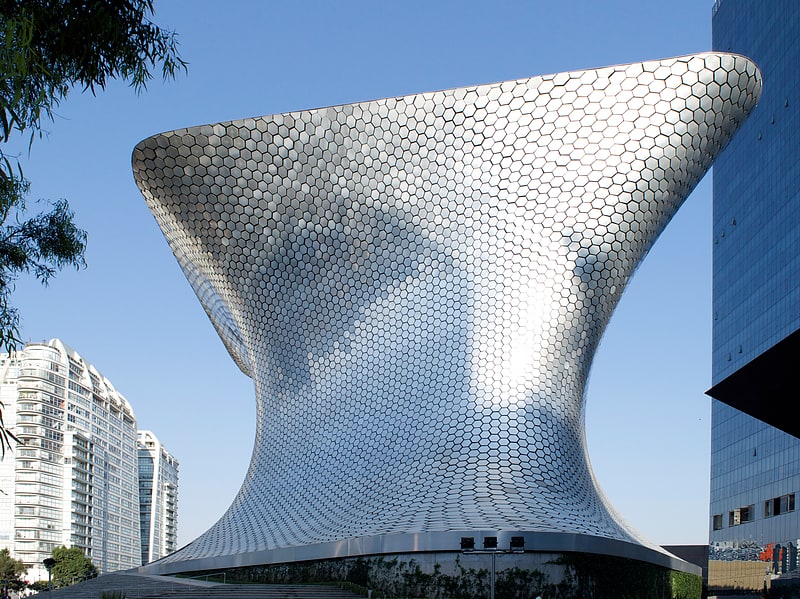
Art museum with many European works. The Museo Soumaya is a private museum in Mexico City and a non-profit cultural institution with two museum buildings in Mexico City — Plaza Carso and Plaza Loreto. It has over 66,000 works from 30 centuries of art including sculptures from Pre-Hispanic Mesoamerica, 19th- and 20th-century Mexican art and an extensive repertoire of works by European old masters and masters of modern western art such as Auguste Rodin, Salvador Dalí, Bartolomé Esteban Murillo and Tintoretto. It is called one of the most complete collections of its kind.
The museum is named after Soumaya Domit, who died in 1999, and was the wife of the founder of the museum Carlos Slim. The museum received an attendance of 1,095,000 in 2013, making it the most visited art museum in Mexico and the 56th in the world that year. In October 2015, the museum welcomed its five millionth visitor. The museum was designed by Fernando Romero's practice, fr·ee.[4]
Address: Blvd. Miguel de Cervantes Saavedra S/N, 11529 Ciudad de México (Miguel Hidalgo)
Xcaret, Playa del Carmen
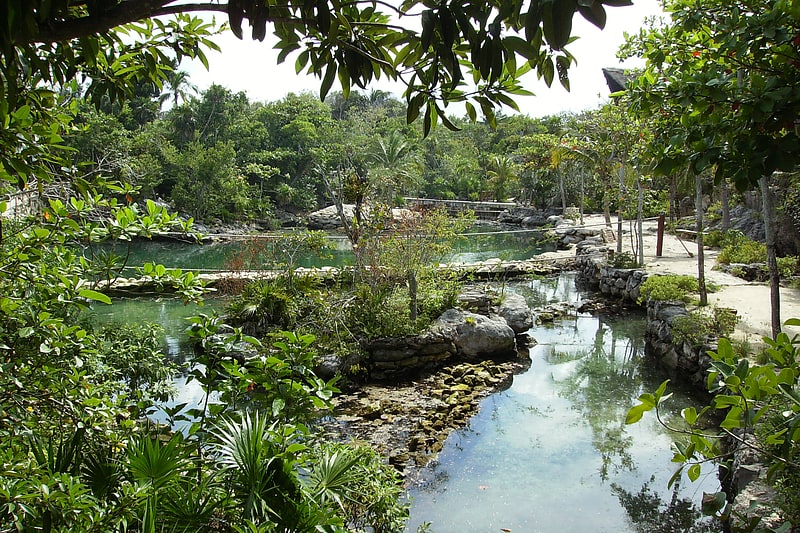
Eco-archaeological park with attractions. Xcaret Park is a privately owned and operated theme park, resort and self-described ecotourism development located in the Riviera Maya, a portion of the Caribbean coastline of Mexico's state of Quintana Roo. It is part of Xcaret Experiencias Group which also owns the Xplor Park, Xel-Ha Park, and Xenses Park; as well as the Xichen, Xenotes, Xavage and Xoximilco tours and activities. It is situated approximately 75 kilometres south of Cancún, and 6.5 kilometres south of the nearest large settlement Playa del Carmen along Highway 307. It is named after the nearby archaeological site Xcaret, a settlement constructed by the pre-Columbian Maya some of whose structures lie within the boundaries of the park's 81 hectares of land holdings.
From 2010 to 2015, Xcaret Experiencias has been recognized as one of The Best Mexican Companies (Las Mejores Empresas Mexicanas), a recognition promoted by Banamex, Deloitte México and Tecnológico de Monterrey.[5]
Address: Carretera Chetumal-Puerto Juarez Km. 282, 77710 Playa del Carmen
Sanctuary of Atotonilco, San Miguel de Allende
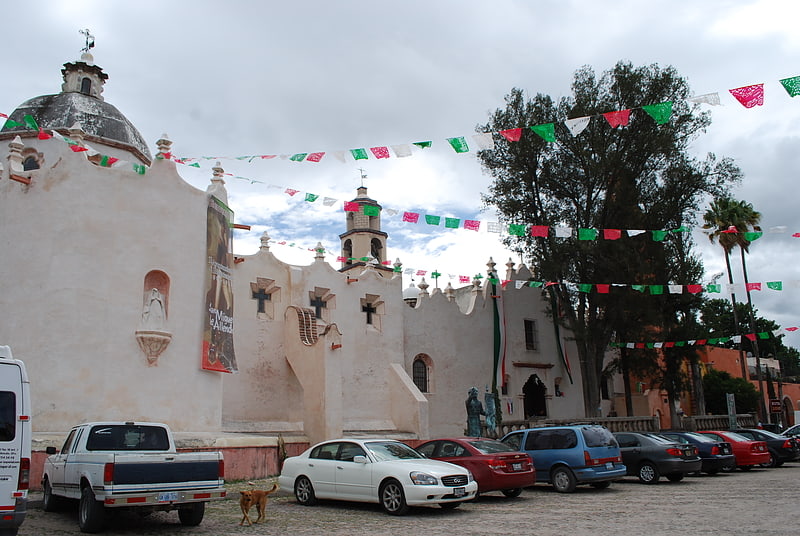
Also known as: Santuario de Jesús Nazareno de Atotonilco
Mural-filled church with fortress facade. The Sanctuary of Atotonilco is a church complex and part of a World Heritage Site, designated along with nearby San Miguel de Allende, Guanajuato, Mexico. The complex was built in the 18th century by Father Luis Felipe Neri de Alfaro, who, according to tradition, was called upon by a vision of Jesus with a crown of thorns on his head with blood on his face and carrying a cross. The main feature of the complex is the rich Mexican Baroque mural work that adorns the main nave and chapels. This was chiefly the work of Antonio Martínez de Pocasangre over a period of thirty years. The mural work has led the complex to be dubbed the "Sistine Chapel of Mexico." The complex remains a place of worship and penance to this day, attracting as many as 5,000 visitors every week.[6]
Address: Principal Atotonilco s/n, 37894 San Miguel de Allende
Xochicalco, Cuernavaca
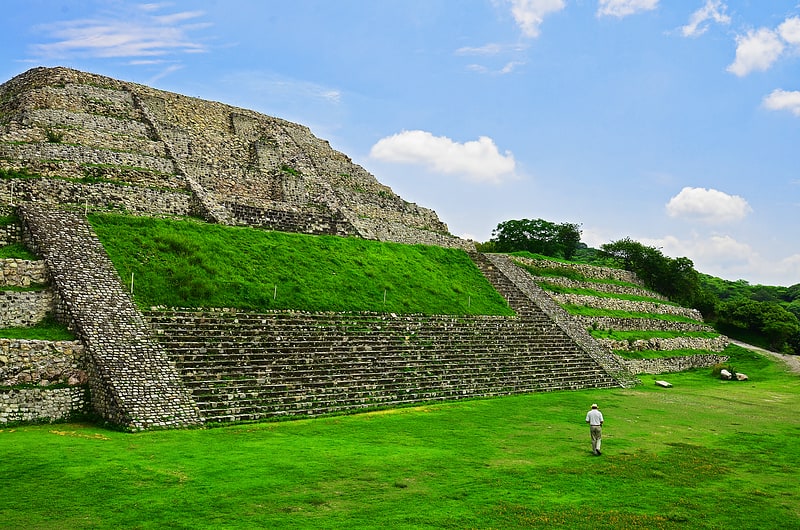
Municipality in Mexico. Xochicalco is a pre-Columbian archaeological site in Miacatlán Municipality in the western part of the Mexican state of Morelos. The name Xochicalco may be translated from Nahuatl as "in the house of Flowers". The site is located 38 km southwest of Cuernavaca, about 76 miles by road from Mexico City. The site is open to visitors all week, from 10 am to 5 pm, although access to the observatory is only allowed after noon. The apogee of Xochicalco came after the fall of Teotihuacan and it has been speculated that Xochicalco may have played a part in the fall of the Teotihuacan empire.
The architecture and iconography of Xochicalco show affinities with Teotihuacan, the Maya area, and the Matlatzinca culture of the Toluca Valley. Today the residents of the nearby village of Cuentepec speak Nahuatl.
The main ceremonial center is atop an artificially leveled hill, with remains of residential structures, mostly unexcavated, on long terraces covering the slopes. The site was first occupied by 200 BC, but did not develop into an urban center until the Epiclassic period (AD 700 – 900). Nearly all the standing architecture at the site was built at this time. At its peak, the city may have had a population of up to 20,000 people.
Xochicalco is an UNESCO World Heritage Site and a tourist destination. The site also has a well-stocked museum.[7]
Address: Carretera a Cuentepec, Cuernavaca
Pirámide del Sol, Teotihuacan

Enormous Teotihuacan pyramid. The Pyramid of the Sun is the largest building in Teotihuacan, and one of the largest in Mesoamerica. It is believed to have been constructed about 200 AD. Found along the Avenue of the Dead, in between the Pyramid of the Moon and the Ciudadela, and in the shadow of the mountain Cerro Gordo, the pyramid is part of a large complex in the heart of the city.[8]
Address: Calle Hidalgo 295, Teotihuacan
Balankanche, Chichen Itza

Also known as: Balankanché
Cave in Mexico. Balankanche is an ancient Maya cave site lying at short distance from the archaeological Maya-Toltec city of Chichen Itza, Yucatan. For more than two thousand years, it has been the focus of rituals dedicated to the Maya rain god, Chaac, and, in the Post-Classic period, also to his Toltec counterpart, Tlaloc. The cave complex was visited by Edward Thompson and Alfred Tozzer in 1905 and has since 1932 been explored and studied by various Mexican and US scholars. Small buildings and platforms surrounded the cave's entrance; inside, stairs, walls, altars and ritual displays of ceramics and small stone implements were discovered. The site has been made accessible for tourists.[9]
Dzibilchaltun, Mérida
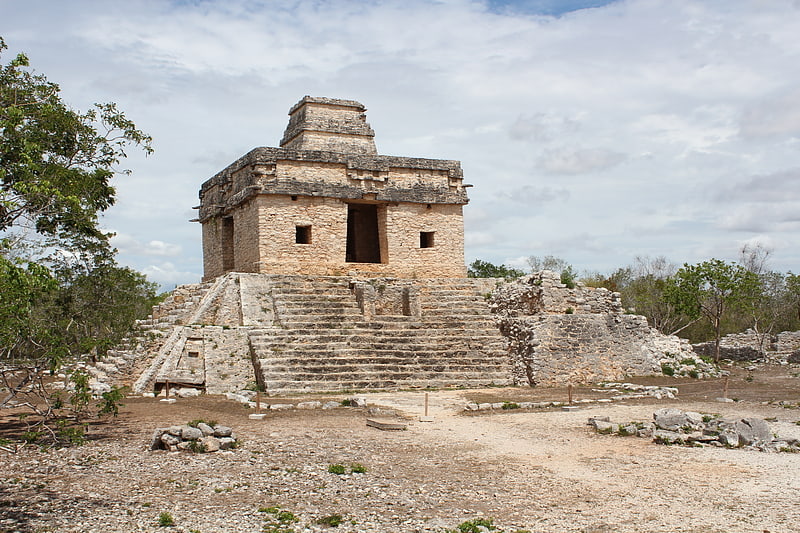
Also known as: Dzibilchaltún
Archaeological site in Mexico. Dzibilchaltún is a Maya archaeological site in the Mexican state of Yucatán, approximately 10 miles north of state capital Mérida.[10]
Guadalajara Zoo, Guadalajara

Also known as: Zoológico Guadalajara
Zoological park in Guadalajara, Mexico. Zoológico Guadalajara is the main zoological park in the Mexican city of Guadalajara, Jalisco, and is widely considered the most important in Latin America. It is the largest in the country with respect to species population.[11]
Address: Avenida Paseo del Zoológico 600, Guadalajara (Zona Huentitán)
Paradise Beach, Cozumel
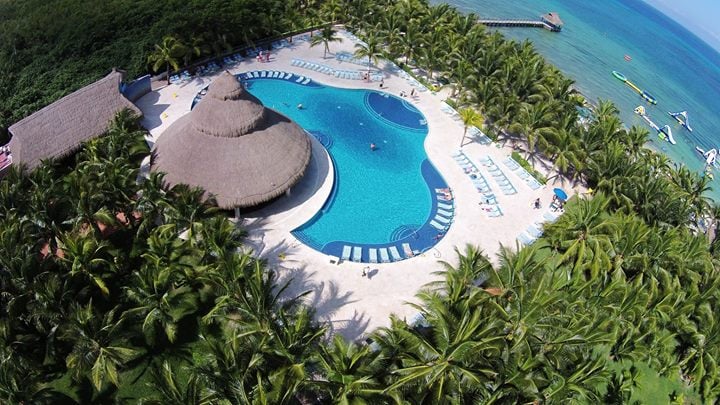
Beach, Beach and pool clubs, Outdoor activities
Address: Carretera Costera Sur Km 14.5, 77600 Cozumel
Pirámide de la Luna, Teotihuacan
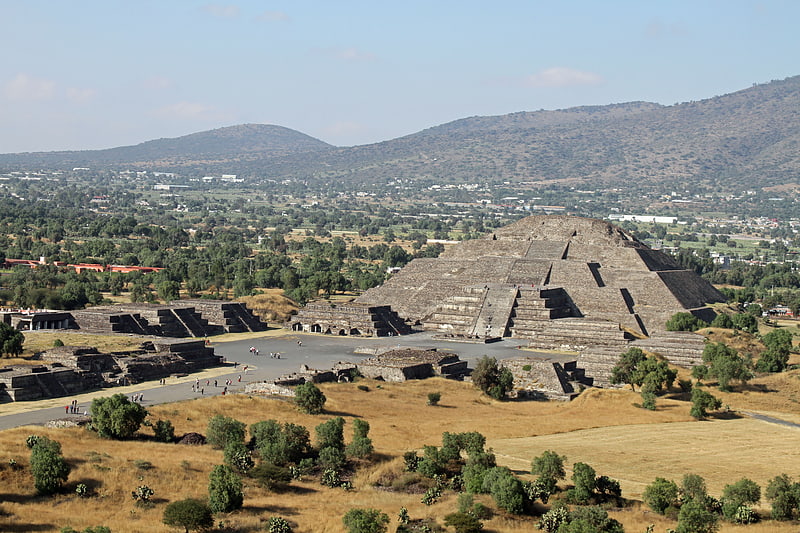
The Pyramid of the Moon is the second largest pyramid in Mesoamerica, after the Pyramid of the Sun, and located in modern-day San Martín de las Pirámides, Mexico. It is found in the western part of the ancient city of Teotihuacan and mimics the contours of the mountain Cerro Gordo, just north of the site. Cerro Gordo may have been called Tenan, which in Nahuatl, means "mother or protective stone". The Pyramid of the Moon covers a structure older than the Pyramid of the Sun which existed prior to 200 AD.
The Pyramid's construction between 100 and 450 AD completed the bilateral symmetry of the temple complex. The pyramid is located at the end of the Avenue of the Dead, connected by a staircase, and was used as a stage for performing ritual sacrifices of animals and humans upon. It was also a burial ground for sacrificial victims. These burials were done in order to legitimize the addition of another pyramid layer over the existing one. The passing of several rulers, and rapid changes in ideologies, led to the Pyramid of the Moon's exponential expansion between 250 and 400 AD. A platform atop the pyramid was used to conduct ceremonies in honor of the Great Goddess of Teotihuacan, the goddess of water, fertility, the earth, and even creation itself. This platform and the sculpture found at the pyramid's bottom are thus dedicated to The Great Goddess.
Opposite the Great Goddess's altar is the Plaza of the Moon. The Plaza contains a central altar and an original construction with internal divisions, consisting of four rectangular and diagonal bodies that formed what is known as the "Teotihuacan Cross."[12]
Address: Calzada de los Muertos, Teotihuacan
Estadio de Béisbol Beto Ávila, Cancún

Also known as: Estadio Beto Ávila
Stadium in Cancún, Mexico. Estadio de Béisbol Beto Ávila is a stadium in Cancún, Mexico. It is primarily used for baseball, and is the home field of the Quintana Roo Tigres Mexican League baseball team. It has a capacity of 9,500 people. It is named to honor Beto Ávila the former Mexican major league baseball most remembered for his years with the Cleveland Indians where he won the American League batting title in 1954 with an average of.341, and where he was selected to the AL All Star Team in 1952, '54, and '55. After splitting time with the Baltimore Orioles, Boston Red Sox, and Milwaukee Braves in 1959, his last year of active play was with the Tigres del México.
In the 1980s the park, originally with a capacity of 4,500 was the homefield of the Marlins de Cancún. It became an LMB park in 1996 when the Langosteros de Quintana Roo (Quintana Roo Lobstermen) were promoted to that league. The park was expanded to seat 7,000. However, after the Lobstermen left Cancún the stadium was heavily damaged by Hurricane Wilma in October 2005. In 2006 renovations were undertaken to rebuild and expand the stadium and draw an LMB team back to Cancún. After the 28 million peso renovation the Tigres played the 2007 season with Beto Ávila as their homefield.[13]
Address: Av. Circuito Mayapan s/n mza 4 L4, 77500 Cancún
Sacred Cenote, Chichen Itza

Also known as: Cenote sagrado de Chichén Itzá
The Sacred Cenote is a water-filled sinkhole in limestone at the pre-Columbian Maya archaeological site of Chichen Itza, in the northern Yucatán Peninsula. It is located to the north of Chichen Itza's civic precinct, to which it is connected by a 300-metre sacbe, a raised pathway.
According to both Maya and Spanish post-Conquest sources, pre-Columbian Maya deposited valuables and human bodies into the cenote as a form of sacrifice to the rain god Chaac.
Edward Herbert Thompson dredged the Cenote Sagrado from 1904 to 1910, and recovered artifacts of gold, jade, pottery, and incense, as well as human remains. Beginning in the 1950s several Mexican-driven projects were conducted in the cenote, including a 1961 project that used an airlift dredge.[14]
Great Pyramid of Cholula, Puebla
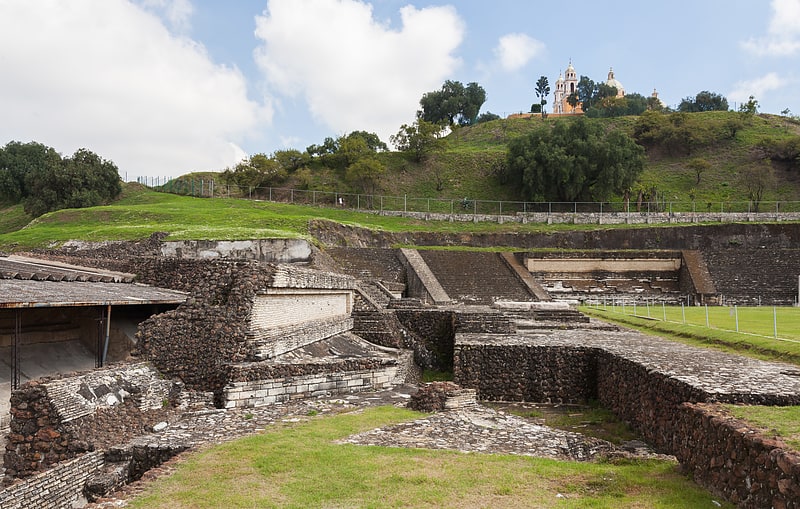
Also known as: Gran Pirámide de Cholula
Archaeological site in San Andrés Cholula, Puebla, Mexico. The Great Pyramid of Cholula, also known as Tlachihualtepetl, is a huge complex located in Cholula, Puebla, Mexico. It is the largest archaeological site of a pyramid in the New World, as well as the largest pyramid by volume known to exist in the world today. The adobe brick pyramid stands 55 metres above the surrounding plain, far shorter than the 137 metres of the Great Pyramid of Giza, but is much wider, in its final form measuring 450 by 450 metres, compared to the Great Pyramid at 230 by 230 metres. The pyramid is a temple that traditionally has been viewed as having been dedicated to the god Quetzalcoatl. The architectural style of the building was linked closely to that of Teotihuacan in the Valley of Mexico, although influence from the Gulf Coast also is evident, especially from El Tajín.[15]
Address: 14 Poniente 605, 72750 San Andrés Cholula
Fuerte de San Diego, Acapulco
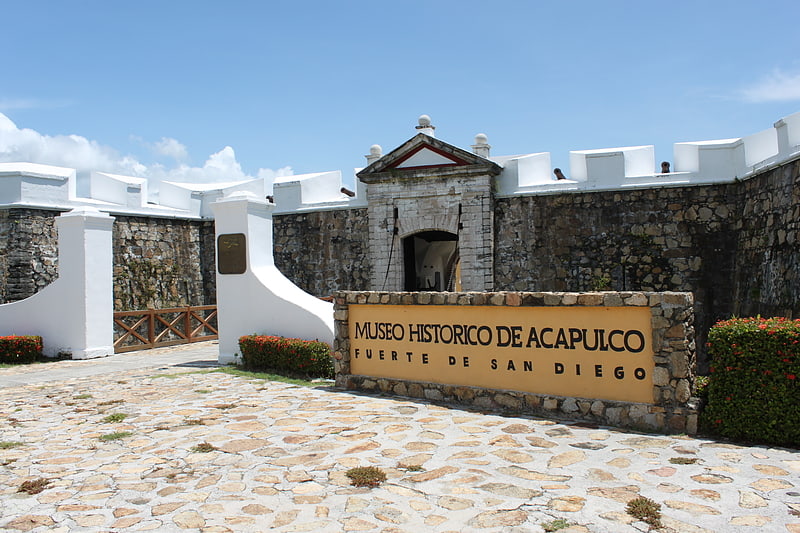
Museum in Acapulco, Mexico. The Fort of San Diego, formerly also known as the Fort of San Carlos is a star fort in Acapulco, Guerrero, Mexico. It was built by the Spanish Empire, and it was one of the most important Spanish fortifications along the Pacific coast. The fort was first built in the 17th century, but was completely rebuilt in the 18th century. Today, it is an important landmark in Acapulco, and it is open to the public as the Acapulco Historic Museum.[16]
Address: Calle Hornitos s/n, 39300 Acapulco (Acapulco Tradicional)
San Juan de Ulúa, Veracruz
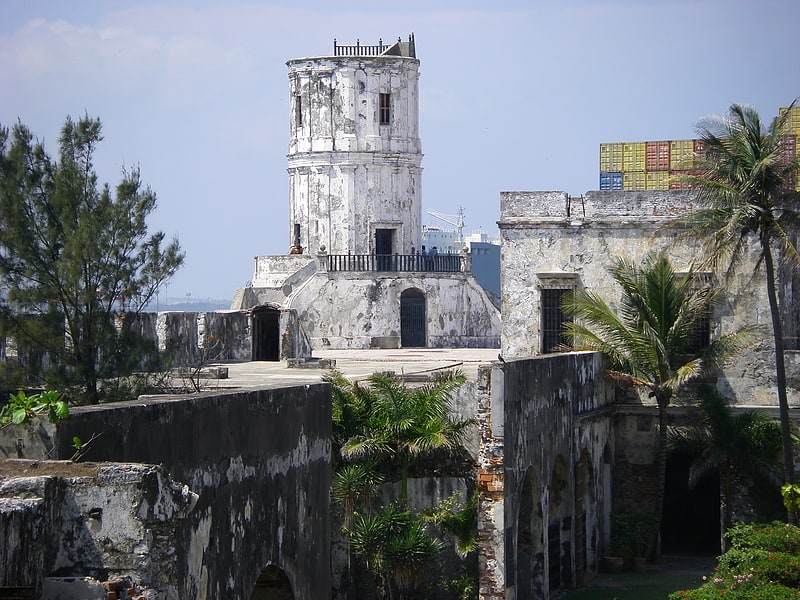
Historic fortress on an island. San Juan de Ulúa, also known as Castle of San Juan de Ulúa, is a large complex of fortresses, prisons and one former palace on an island of the same name in the Gulf of Mexico overlooking the seaport of Veracruz, Mexico. Juan de Grijalva's 1518 expedition named the island. On Easter Sunday 1519, Hernan Cortés met with Tendile and Pitalpitoque, emissaries from Moctezuma II's Aztec Empire.
It was built between 1535 and 1769. There is a local museum of the fortress, inaugurated in 1984.[17]
Address: Camino Escénico a San Juan de Ulúa S/N, 91700 Veracruz
Macroplaza, Monterrey
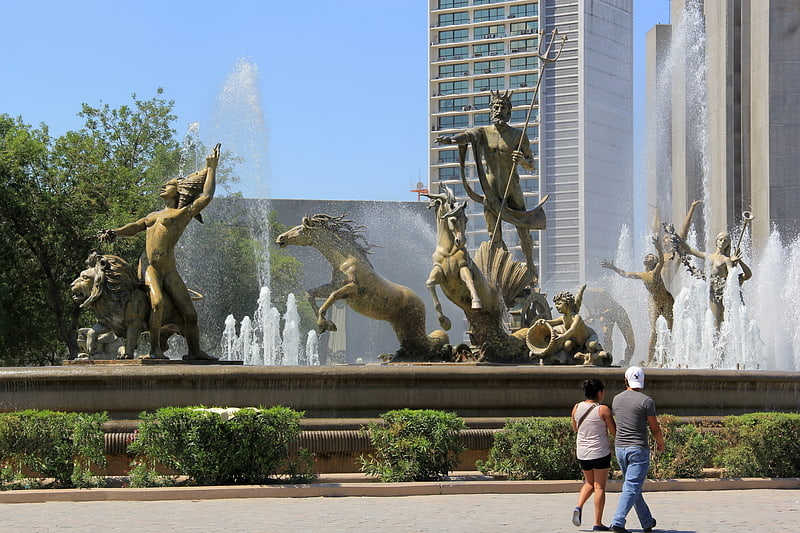
Iconic plaza almost 100 acres in size. The Macroplaza or La Gran Plaza is a town square or plaza located in the heart of the city of Monterrey, Mexico.
The Macroplaza is the fifth-largest plaza in the world and the largest Plaza in Mexico. It has an extension of 400,000 square metres consisting of various monuments, smaller plazas and gardens.
The Macroplaza was built in the early 1980s during the governorship of Alfonso Martínez Domínguez. The construction of the Macroplaza required the demolition of several old buildings and houses including a famous movie theater.
One of the most iconic monuments of the city is the Faro del Comercio, a 70-meter-tall modern lighthouse located in the same plaza, equipped with a green laser, that shot its light around the city at nights.[18]
Rio Secreto, Playa del Carmen
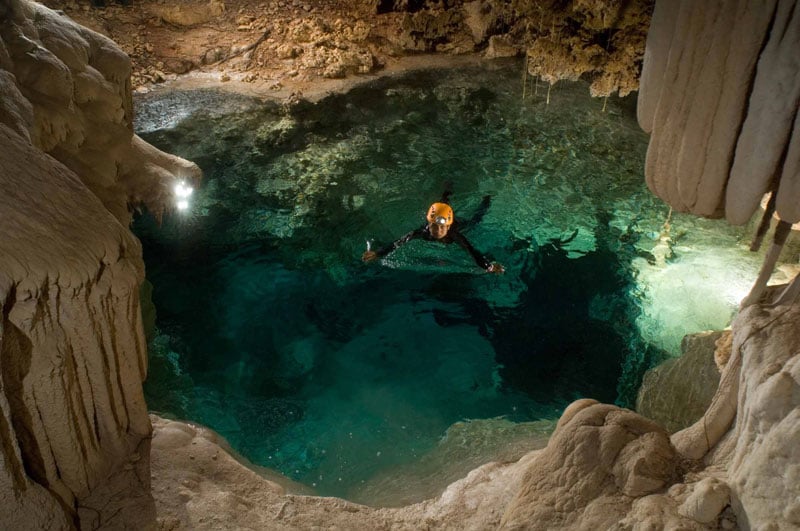
Río Secreto is a semi-flooded limestone cave system near Playa del Carmen, Quintana Roo, Mexico. There are 38 kilometers of caves in the system, of which approximately 10% are used for ecotourism. Currently, Río Secreto is protected as a nature reserve.[19]
Address: Carretera Federal Libre Chetumal _ Puerto Juarez Km 283.5, 77712 Playa del Carmen
Cuernavaca Cathedral, Cuernavaca

Also known as: Catedral de Cuernavaca
Cathedral in Cuernavaca, Mexico. The Cuernavaca Cathedral is the Roman Catholic church of the Diocese of Cuernavaca, located in the city of Cuernavaca, Morelos, Mexico. The church and its surrounding monastery is one of the early 16th century monasteries in the vicinity of the Popocatepetl volcano, built initially for evangelization efforts of indigenous people after the Spanish conquest of the Aztec Empire. By the 18th century, the church of the monastery began to function as the parish church of the city and in the late 19th century, it was elevated to the rank of a cathedral. Unlike many cathedrals in Mexico, this one does not face the city's main square, but rather is located just to the south, in its own walled compound, which it shares with a number of other structures. Unlike the other monastery structures from its time, the importance of this church provoked a number of renovation projects, the last of which occurred in 1957. This one took out the remaining older decorations of the interior and replaced them with simple modern ones. This renovation work also uncovered a 17th-century mural that covers 400 square metres of the interior walls and narrates the story of Philip of Jesus and twenty three other missionaries who were crucified in Japan.[20]
Address: Miguel Hidalgo 17, 62000 Cuernavaca
Paseo de Montejo, Mérida
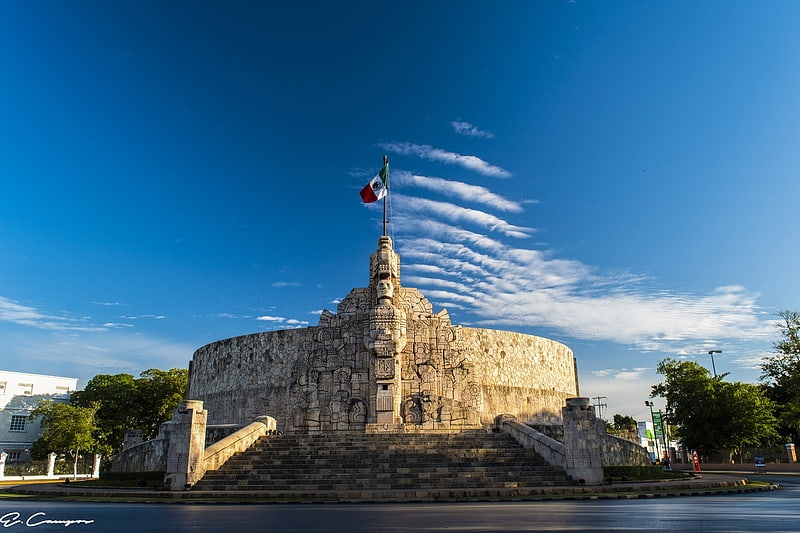
Paseo de Montejo is a notable avenue of Mérida, México. It is named after Francisco de Montejo, the Spanish conquistador who founded the city in 1542, and is the location of some of the most iconic buildings and monuments of the city. Inspired by the French boulevard, the avenue is flanked by trees and has several roundabouts along its course. Many beautiful mansions were built along the avenue by wealthy Yucatecans of the 19th century.
It extends north from the city downtown (the Santa Ana neighbourhood) and connects into highway 231 just south of the Mayan Museum (Gran Museo Maya). Its length of over 6 km makes it one of the longest avenues of the city.[21]
Our Lady of Solitude Cathedral, Acapulco
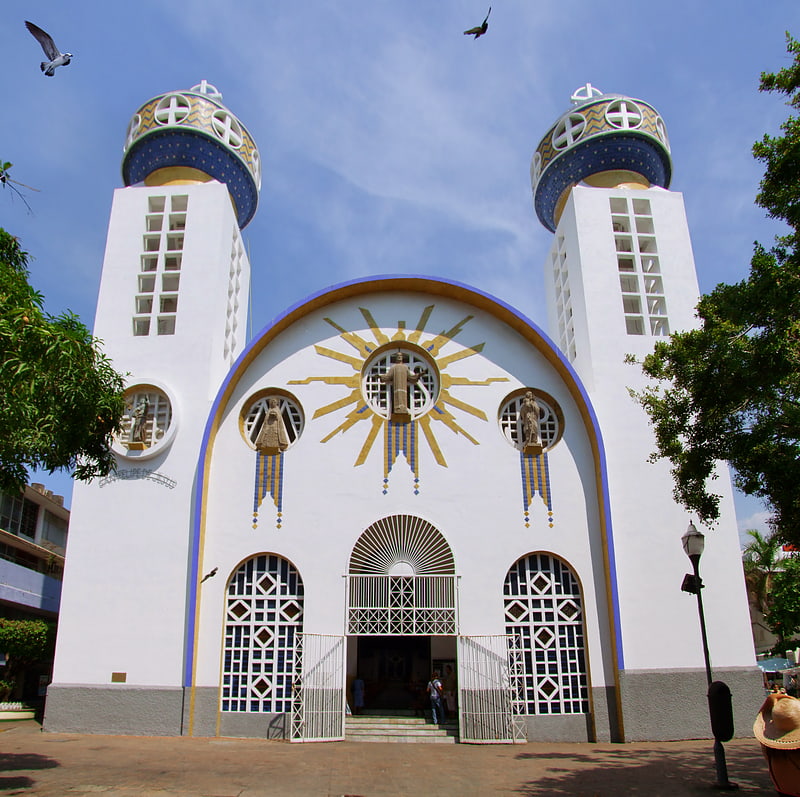
The Our Lady of Solitude Cathedral Also Acapulco Cathedral Is the main Catholic temple of the city of Acapulco, Guerrero, Mexico located in the center of the city, in front of the Álvarez Square. It is the episcopal seat of the Archdiocese of Acapulco since 1958. It combines architecturally styles that were amalgamated during and after the construction, since you can admire details of both the neocolonial architecture and the Moorish and Byzantine style, the latter in the dome and the towers. The interior of the church is decorated with gold tiles and mosaics.
The space occupied by the building has been used for public worship since the creation of the Parish in 1555. From 1940, the architect Federico Mariscal was commissioned to design and reconstruct the parish, a process that was completed until the 1950s decade.[22]
Address: Zócalo de la Ciudad, Acapulco (Acapulco Tradicional)
San Gervasio, Cozumel
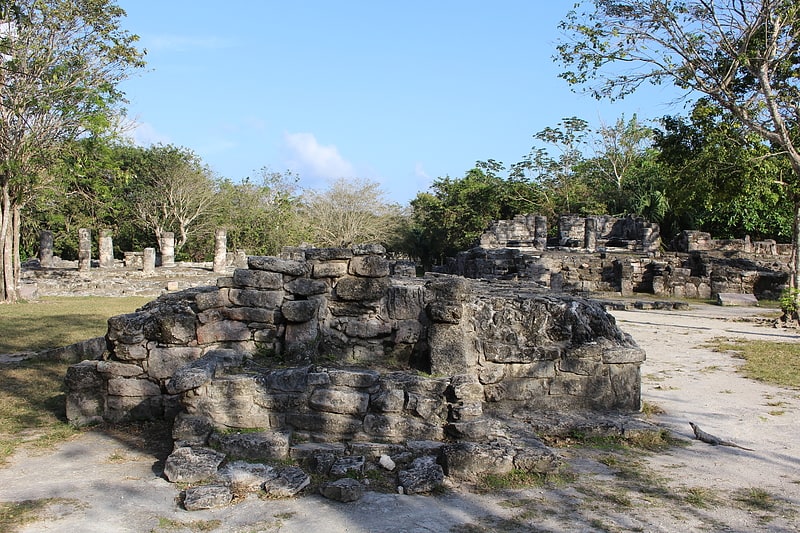
Also known as: Cozumel
Archaeological site in Mexico. San Gervasio is an archaeological site of the pre-Columbian Maya civilization, located in the northern third of the island of Cozumel off the northeastern coast of the Yucatán Peninsula, in what is now the Mexican state of Quintana Roo. San Gervasio's pre-Hispanic name was Tantun Cuzamil, Mayan for Flat Rock in the place of the Swallows. The ruins were once a hub of worship of the goddess Ix Chel, an aged deity of childbirth, fertility, medicine, and weaving. Pre-Columbian Maya women would try to travel to San Gervasio and make offerings at least once in their lives. In 1560, the Spanish historian, Diego Lopez de Cogolludo, wrote: "The pilgrims arrive at Cozumel for the fulfillment of their vows to offer their sacrifices, to ask help for their needs, and for the mistaken adoration of their false gods." The bishop of Yucatán, Diego de Landa, wrote in 1549 that the Maya "held Cozumel in the same veneration as we have for pilgrimages to Jerusalem and Rome, and so they used to go to visit and offer presents there, as we do to holy places; and if they did not go themselves, they always sent their offerings."[23]
Africam Safari, Puebla
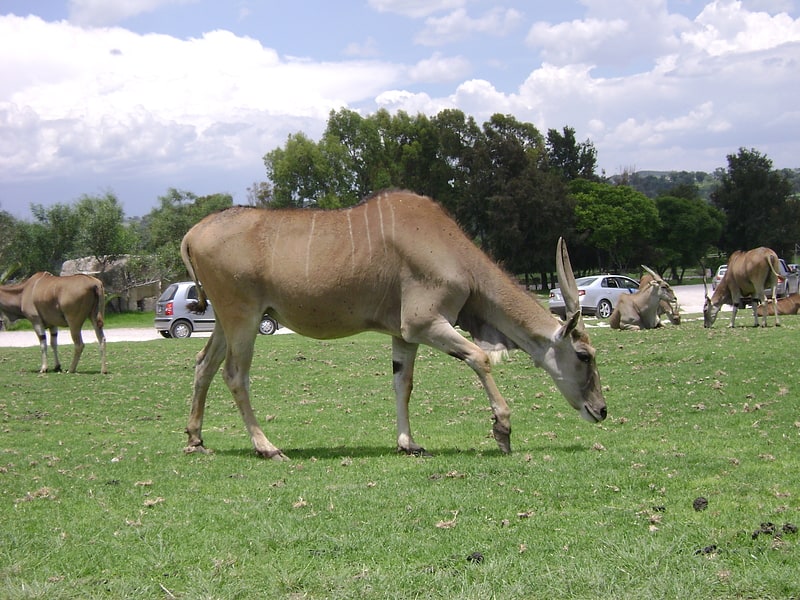
Zoo with African-style safari tours. Africam Safari is a Mexican safari park that was established in 1972 by Captain Carlos Camacho Espíritu. It is about 17 kilometres from the city of Puebla, Mexico.
Africam Safari is accredited by the Association of Zoos and Aquariums (AZA) and the World Association of Zoos and Aquariums (WAZA).[24]
Address: Blvd. Cap. Carlos Camacho Espíritu Km 16.5,Barrios de Arboledas,72260 Heroica Puebla de Zaragoza, Puebla,Mexiko, Puebla
Alhóndiga de Granaditas, Guanajuato
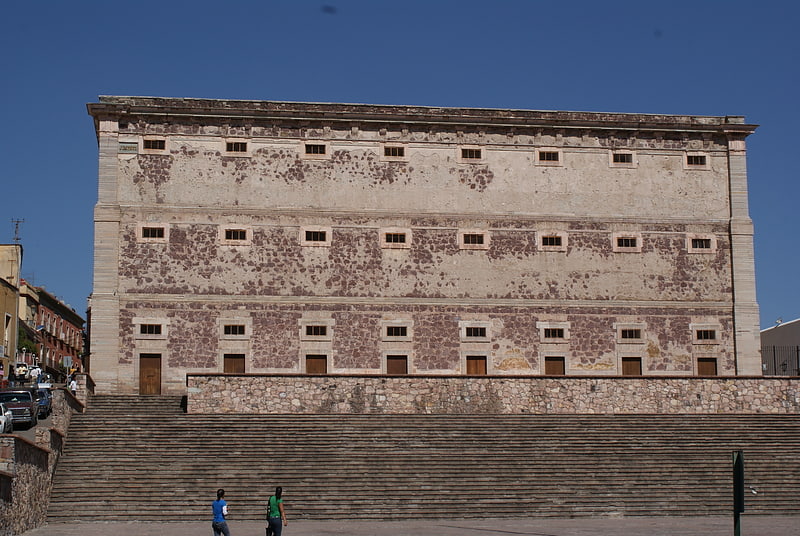
Art and history museum in a historic space. The Alhóndiga de Granaditas is an old grain storage building in Guanajuato City, Mexico. This historic building was created to replace an old grain exchange near the city's river. The name Alhóndiga translates roughly from both Arabic and Spanish as grain market or warehouse. It is equivalent to the regional grain exchange. Its construction lasted from 1798 to 1809, by orders of Juan Antonio de Riaño y Bárcena, a Spaniard who was the quartermaster of the city during the Viceroyalty of New Spain. Miguel Hidalgo y Costilla helped build it. The building received World Heritage listing as part of the Historic Town of Guanajuato in 1988.[25]
Address: Calle Mendizabal 6, 36000 Guanajuato
Fundidora Park, Monterrey

Also known as: Parque Fundidora
Park in Monterrey, Mexico. Fundidora Park is an urban park located in the Mexican city of Monterrey, built in what once where the grounds of the Fundidora Monterrey steel foundry company.[26]
Address: Av. Fundidora S/N, 64010 Monterrey (Zona Rosa)
Templo de Santo Domingo de Guzmán, Oaxaca
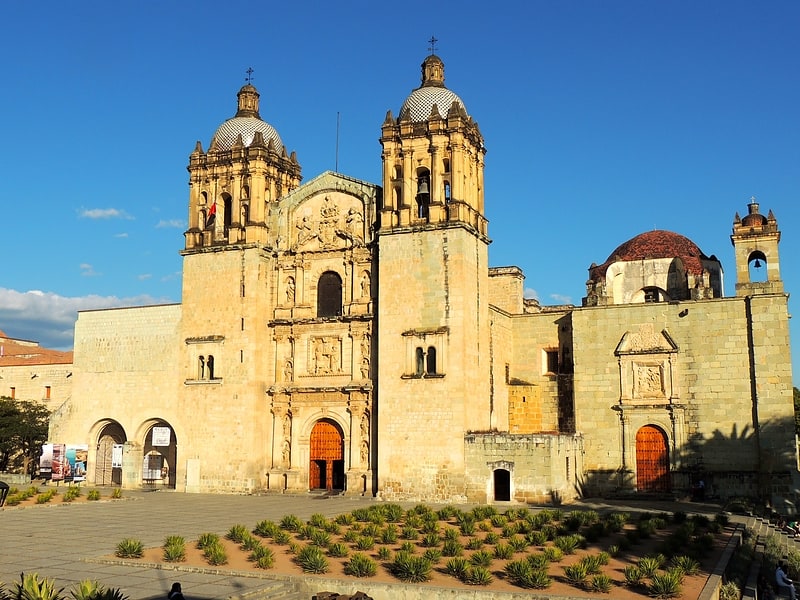
Ornate church and former monastery. The Church and former monastery of Santo Domingo de Guzmán is a Baroque ecclesiastical building complex in Oaxaca, Oaxaca, Mexico. The complex includes a substantial sanctuary and an extensive system of courtyards, cloisters and rooms that formerly constituted the monastery.[27]
Address: Macedonio Alcalá, 68000 Oaxaca de Juárez
Guadalajara Cathedral, Guadalajara
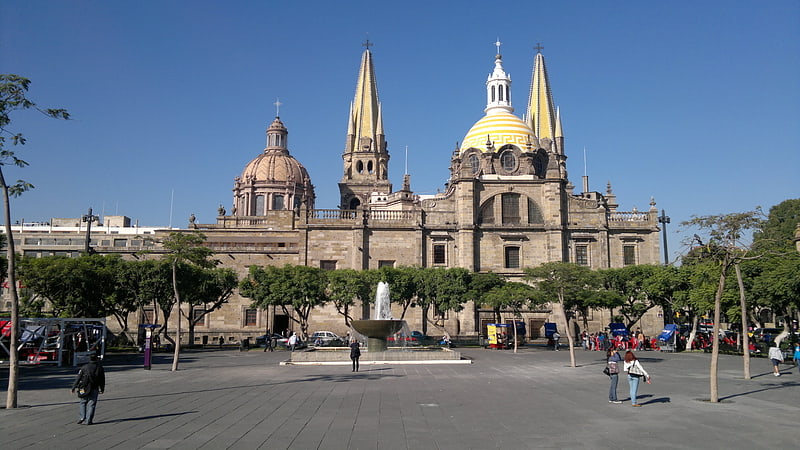
Also known as: Catedral de Guadalajara
Ornate cathedral with relics of a saint. The Guadalajara Cathedral or Cathedral of the Assumption of Our Lady, located in Centro, Guadalajara, Jalisco, is the Roman Catholic cathedral of the Archdiocese of Guadalajara and a minor basilica. It is built in the Spanish Renaissance style, except its Neo-gothic spires.[28]
Address: Av Alcalde 10, 44100 Guadalajara (Zona Centro)
Club de Yates, Acapulco

Boat club in Acapulco, Mexico. Club de Yates de Acapulco is a yacht club located in Acapulco, Mexico. Opened in December 1955, it served as host of the sailing events for the 1968 Summer Olympics in Mexico City.
Since the 1968 Games, the yacht club continues to serve as a sailing venue.[29]
Address: Gran Vía Tropical S/N, 39390 Acapulco (Acapulco Tradicional)
Puebla Cathedral, Puebla
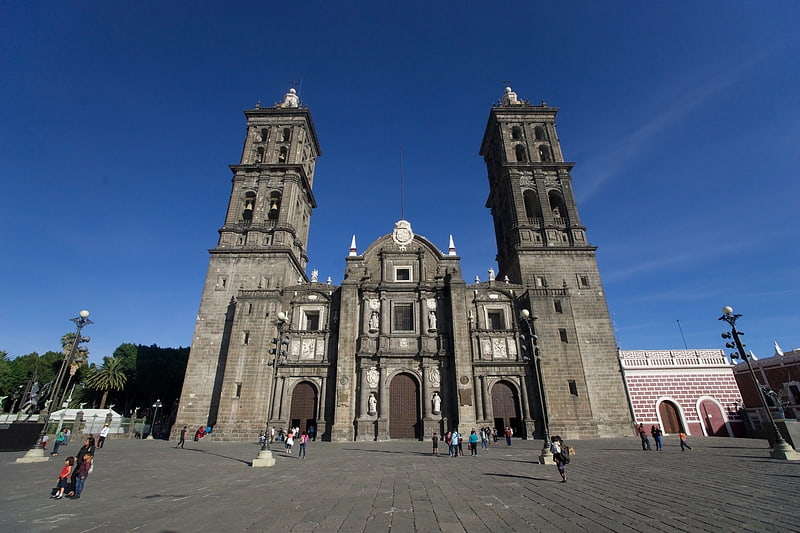
Also known as: Catedral de Puebla
Grand cathedral with an octagonal altar. Puebla Cathedral is a Roman Catholic church in the city of Puebla's historic centre, in the state of Puebla, Mexico. It is a colonial cathedral, and is the see of the Roman Catholic Archdiocese of Puebla de los Ángeles. The cathedral's archbishop is Víctor Sánchez Espinosa. The cathedral is dedicated to the Immaculate Conception.[30]
Address: 16 de Septiembre 305, 72000 Puebla
Mummies of Guanajuato, Guanajuato
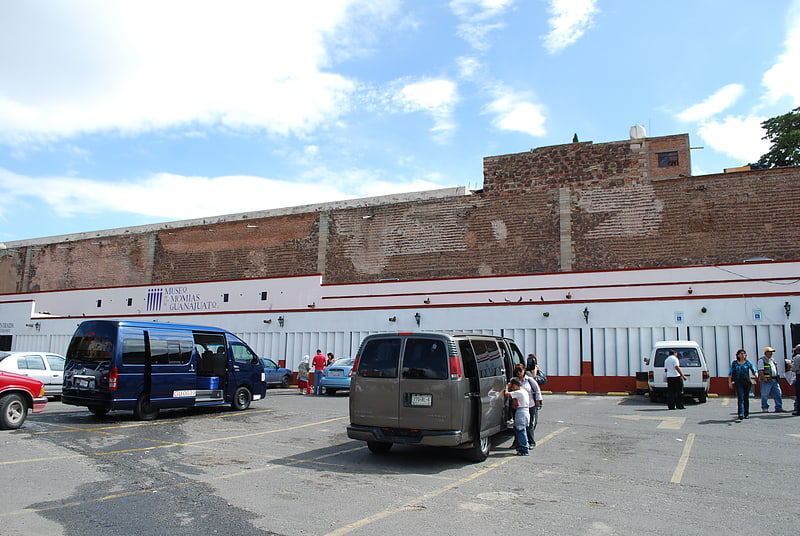
Also known as: Momias de Guanajuato
The Mummies of Guanajuato are a number of naturally mummified bodies interred during a cholera outbreak around Guanajuato, Mexico in 1833.
The human bodies appear to have been disinterred between 1870 and 1958. During that time, a local tax was in place requiring a fee to be paid for "perpetual" burial. Some bodies for which the tax was not paid were disinterred, and some—apparently those in the best condition—were stored in a nearby building. The climate of Guanajuato provides an environment which can lead to a type of natural mummification, although scientific studies later revealed that some bodies had been at least partially embalmed. By the 1900s the mummies began attracting tourists. Cemetery workers began charging people a few pesos to enter the building where bones and mummies were stored.
This place was subsequently turned into a museum called El Museo de las Momias ("The Museum of the Mummies") in 1969. As of 2007, 59 mummies were on display, of a collection that totals 111.[31]
Address: Explanada del Panteon Municipal s/n, 36000 Guanajuato
Monastery of Santiago Apóstol, Oaxaca
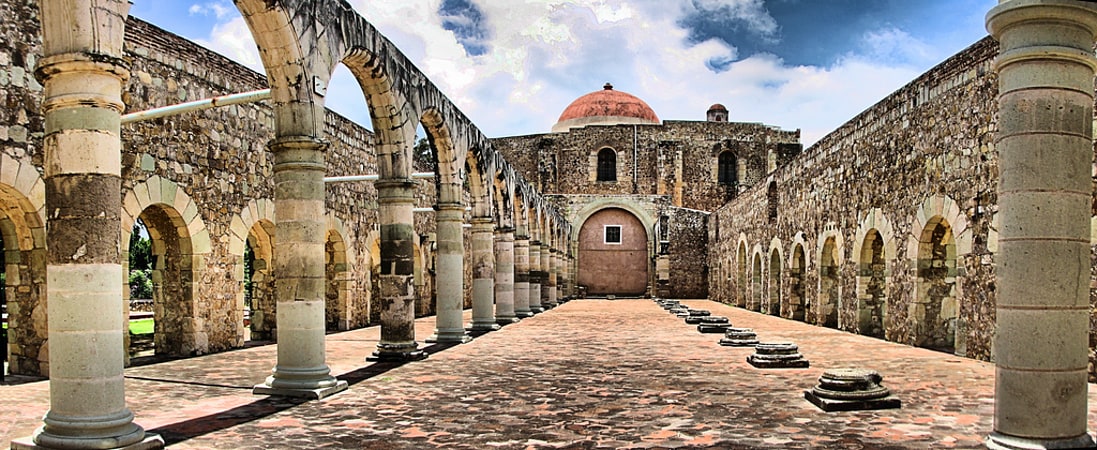
Also known as: Convento de Cuilapan
The Ex-monastery of Santiago Apóstol is located in the town of Cuilapan de Guerrero in the Mexican state of Oaxaca. The fortress-like complex is easily seen from the highway as one travels south from the capital city of Oaxaca on the road leading to Villa de Zaachila, and it is visited by both Mexican and international tourists. The complex is located on a small hill which gives it a view of much of the valley area. It is one of the most extravagant and elaborate colonial era constructions in Oaxaca, but it is often overlooked in favor of churches and monasteries located in the Mexico City area. Built of green quarried stone and river rocks, it is a quiet place where footsteps can echo in the hallways. The extravagances of the site, including the tall basilica, the elaborate baptismal font, the Gothic cloister and murals remain as national treasures. The decorative work of the monastery, especially its murals, are important because they show a systematic blending of indigenous elements into the Christian framework, done in order to support the evangelization process in the local Mixtec and Zapotec peoples. The single-naved church is used for worship but the roofless basilica and cloister are under the control of INAH, which uses many of the second-floor rooms of the cloister as workshops for restoration projects and runs a small museum with important liturgical items from the 16th century.[32]
Address: Cuilapam de Guerrero, Oaxaca
St. Ildephonsus Cathedral, Mérida
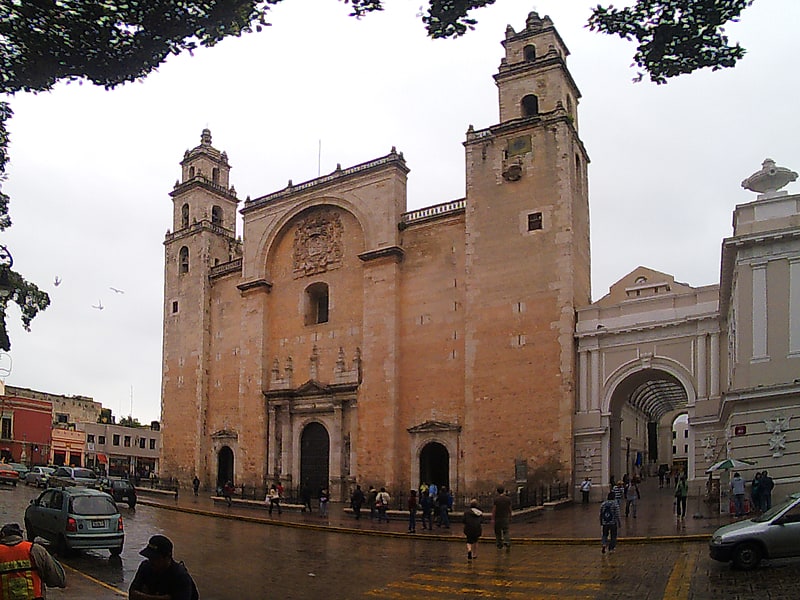
Also known as: Catedral de Yucatán
The Mérida Cathedral in Mérida, Yucatán, Mexico, is one of the oldest cathedrals in the Americas.[33]
Address: Calle 61, 97000 Merida
STINGRAY BEACH COZUMEL, Cozumel
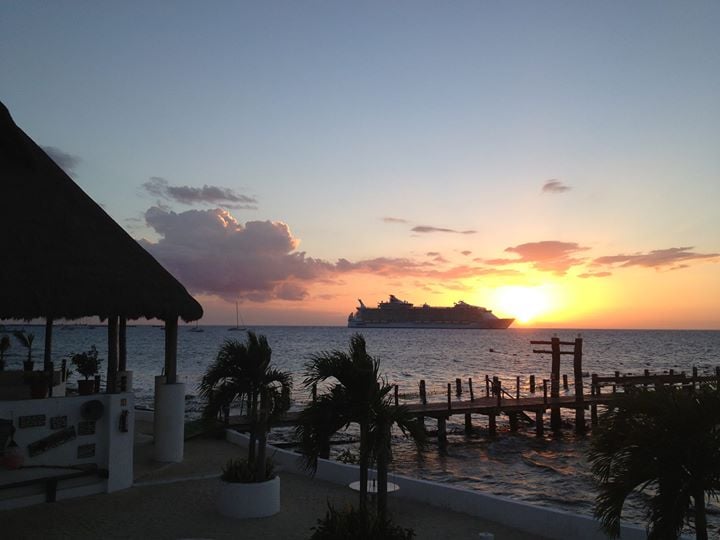
Beach
Address: Avenida General Rafael e Melgar, Cozumel
Templo Expiatorio del Santísimo Sacramento, Guadalajara
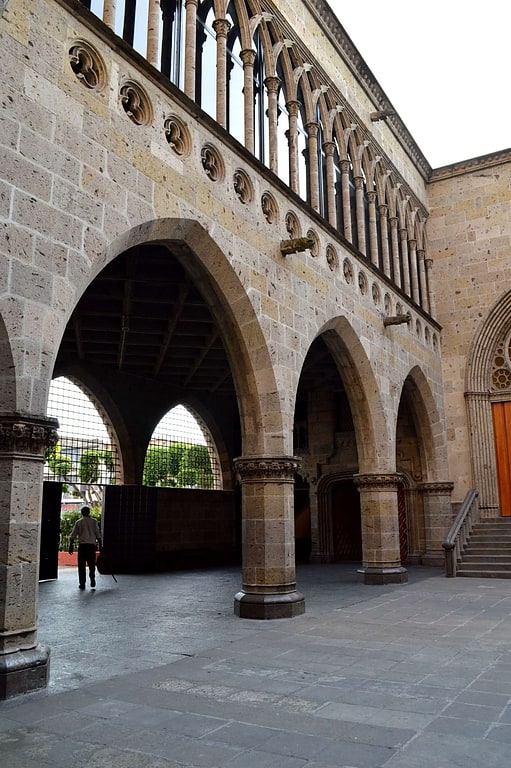
Catholic church in Guadalajara, Mexico. The Templo Expiatorio del Santísimo Sacramento is a Catholic church dedicated to the Blessed Sacrament, located in Guadalajara, Jalisco, Mexico. It is of neo-Gothic style and is considered the greatest work of its kind in Mexico. Its construction began on August 15, 1897 and ended 75 years later in 1972.[34]
Address: López Cotilla 935, Guadalajara (Zona Centro)
Zacatecas Cathedral, Zacatecas

Also known as: Catedral basílica de Zacatecas
Catholic cathedral in Zacatecas, Mexico. The Cathedral Basilica of Zacatecas is a Catholic church in Zacatecas City, Zacatecas, Mexico. It is the head temple of the Diocese of Zacatecas, and is dedicated to Our Lady of the Assumption. The cathedral is located in the historic city center, and was declared a World Heritage Site by UNESCO. The main facade of the premises is known as one of the most outstanding examples of Baroque art in Mexico.[35]
Address: Av. Hidalgo 617, 98000 Zacatecas
Palacio de Gobierno, Monterrey
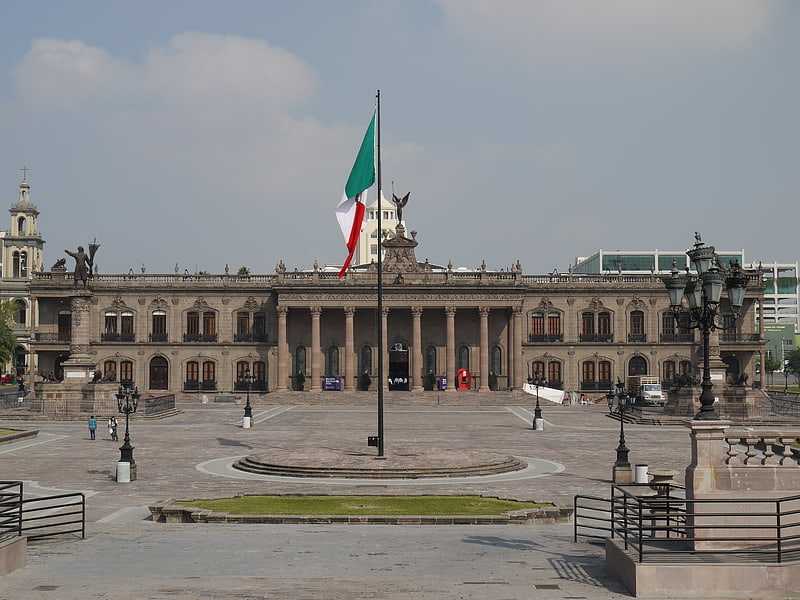
Building in Monterrey, Mexico. The Palacio de Gobierno, or the Government Palace of Nuevo León, is a state government building in Monterrey, the capital city of Nuevo León state, in northern Mexico.
The Neoclassical style building is located in the northernmost section of the Macroplaza in the city.
The Palacio de Gobierno is the location of the office of the Governor of Nuevo León.[36]
Address: Portal del Palacio, Monterrey (Distrito Jardin)
Acuario de Veracruz, Veracruz
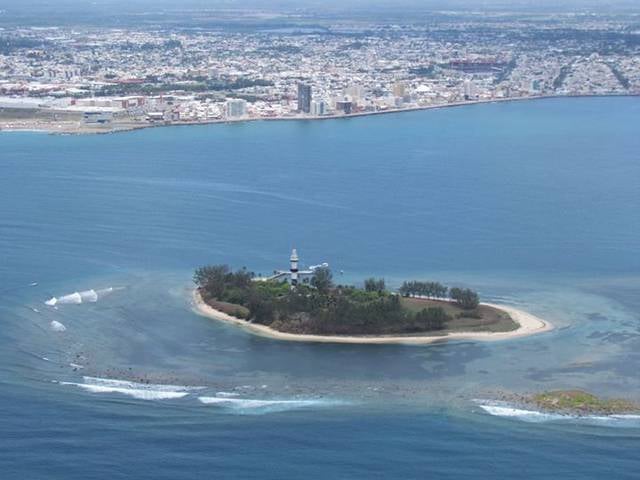
Aquarium in Veracruz, Mexico. The Acuario de Veracruz is a public aquarium located in the city of Veracruz. It is the biggest aquarium in Mexico and Latin America by area, with more than 7,500 square meters.[37]
Address: Manuel Ávila Camacho s/n, 91900 Veracruz
Playa Delfines, Cancún
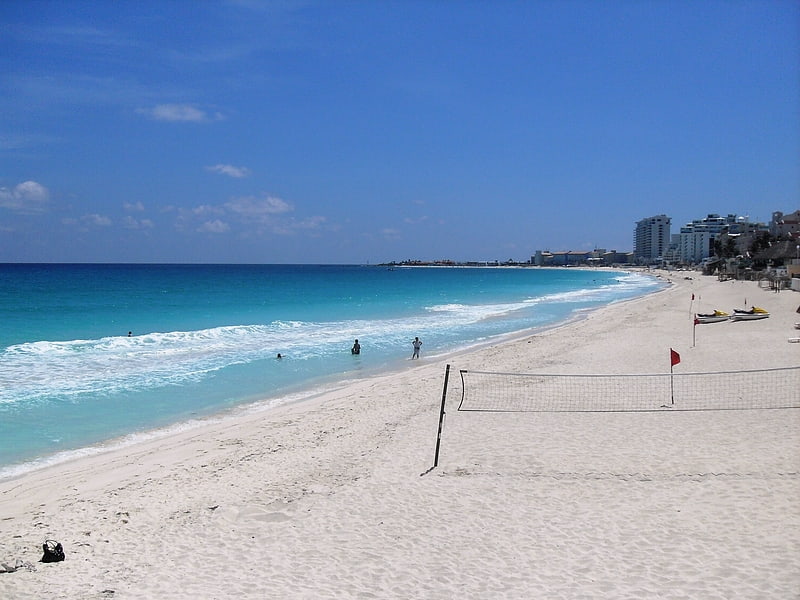
Beach, Outdoor activities, Park, View point
Address: Blvd. Kukulcan km 18.5, 77505 Cancún
Cathedral of Chihuahua, Chihuahua
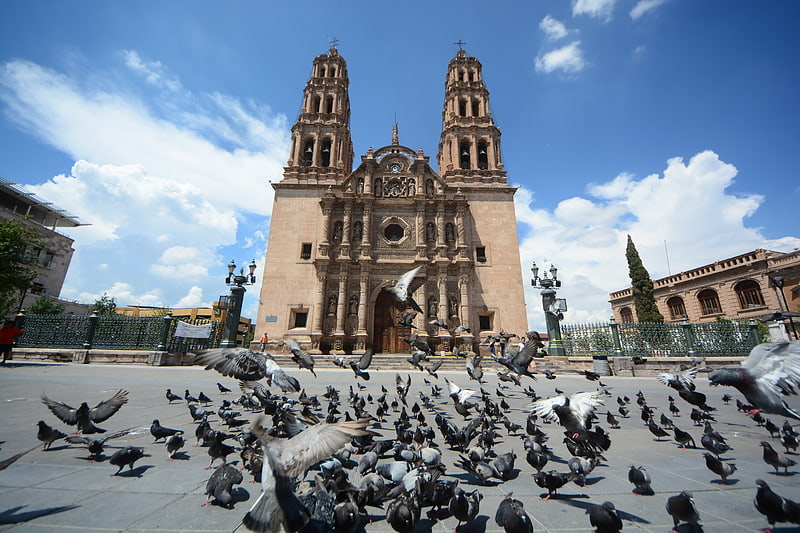
Also known as: Catedral de Chihuahua
Cathedral in Chihuahua, Mexico. The Metropolitan Cathedral Church of the Holy Cross, Our Lady of Regla, and St Francis of Assisi is the main ecclesiastical building of the Catholic Church in Chihuahua City, Chihuahua, Mexico. It is considered perhaps the finest example of colonial architecture in northern Mexico and it was built between 1725-1792. The cathedral is also the seat of the Roman Catholic Archdiocese of Chihuahua. As of 2013 the archbishop was Constancio Miranda Weckmann.[38]
Address: Calle Libertad 814, Chihuahua
Fine Arts Museum of Toluca, Toluca
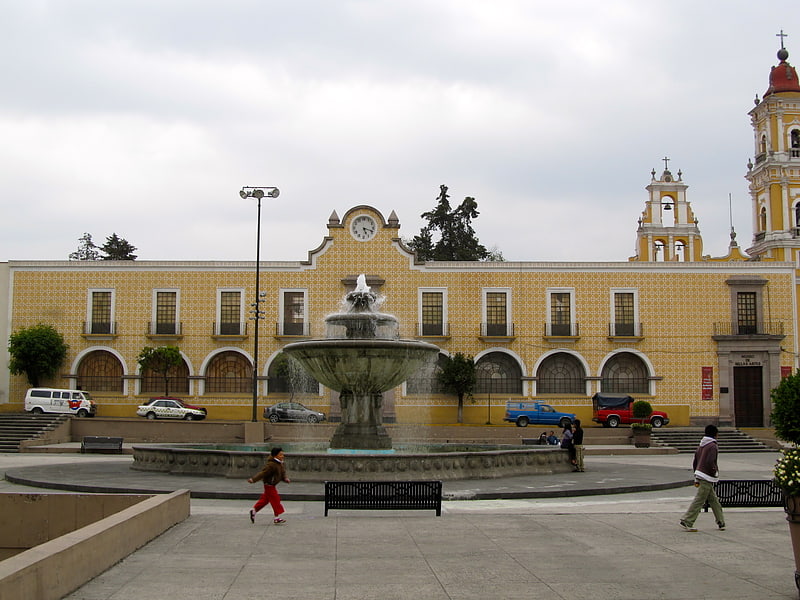
The Fine Arts Museum of Toluca is a museum located in Toluca, Mexico. It is considered one of the most important museums in the State of Mexico for its architectural heritage. It is also one of the oldest museums in the city of Toluca.[39]
Address: Santos Degollado 102, Toluca
Popocatépetl, Iztaccíhuatl–Popocatépetl National Park
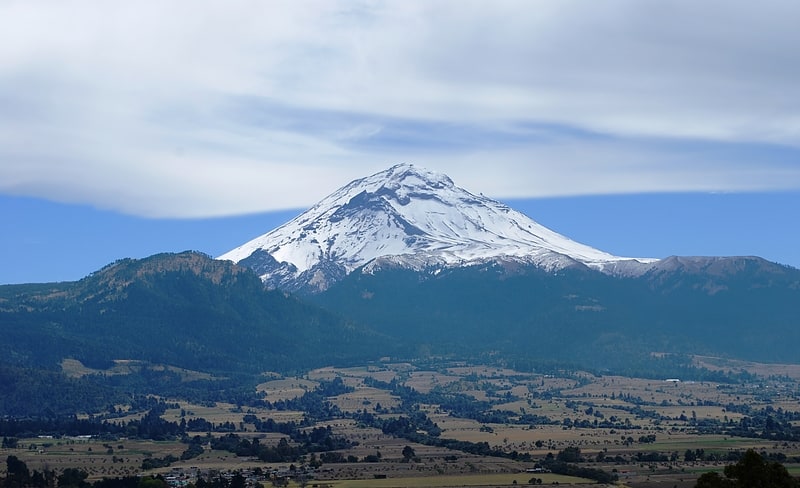
Stratovolcano in Mexico. Popocatépetl is an active stratovolcano located in the states of Puebla, Morelos, and Mexico in central Mexico. It lies in the eastern half of the Trans-Mexican volcanic belt. At 5,426 m it is the second highest peak in Mexico, after Citlaltépetl at 5,636 m.
It is linked to the twin volcano of Iztaccihuatl to the north by the high saddle known as the "Paso de Cortés". Izta-Popo Zoquiapan National Park, wherein the two volcanoes are located, is named after them.
Popocatépetl is 70 km (43 mi) southeast of Mexico City, from where it can be seen regularly, depending on atmospheric conditions. Until recently, the volcano was one of three tall peaks in Mexico to contain glaciers, the others being Iztaccihuatl and Pico de Orizaba. In the 1990s, the glaciers such as Glaciar Norte (North Glacier) greatly decreased in size, partly due to warmer temperatures but largely due to increased volcanic activity. By early 2001, Popocatépetl's glaciers were gone; ice remained on the volcano, but no longer displayed the characteristic features of glaciers such as crevasses.
Lava erupting from Popocatépetl has historically been predominantly andesitic, but it has also erupted large volumes of dacite. Magma produced in the current cycle of activity tends to be a mixture of the two with the andesites being rich in magnesium.[40]
Cosmovitral, Toluca
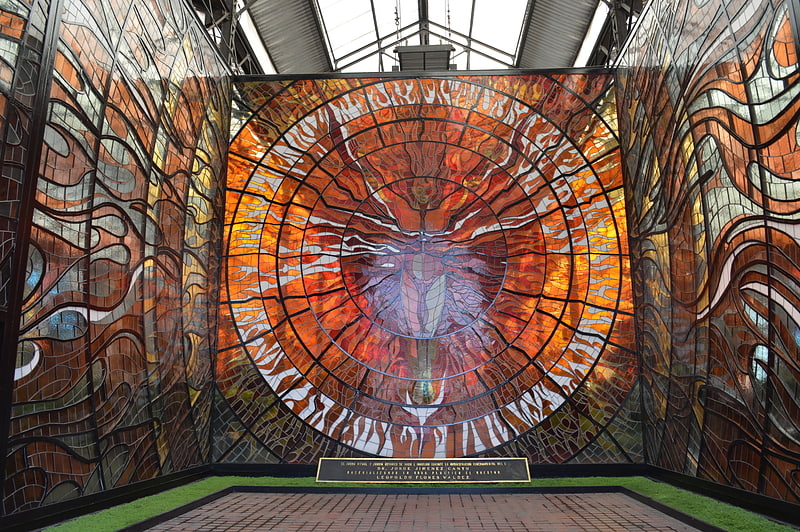
Botanical garden with stained glass. The Cosmovitral is a stained glass mural and botanical garden located in Toluca, Mexico. The building takes its name from the mural which is set in the building's huge windows that surround the building and in the ceiling. The building originally was constructed in 1910 as the 16 de Septiembre Market. It was not until 1975 when the first female Mayor of Toluca, Yolanda Sentíes, had the 16 de Septiembre Market reallocated and successfully gauged enough social and political support to transform the building into a space for art. The Cosmovitral was designed by the notable local artisan Leopoldo Flores.[41]
Address: S. Lerdo de Tejada, 50000 Toluca de Lerdo
Playa Marlín, Cancún

Beach, Park, Outdoor activities
Address: Blvd. Kukulcan Km. 13, 77500 Cancún
Palace of Quetzalpapálotl, Teotihuacan
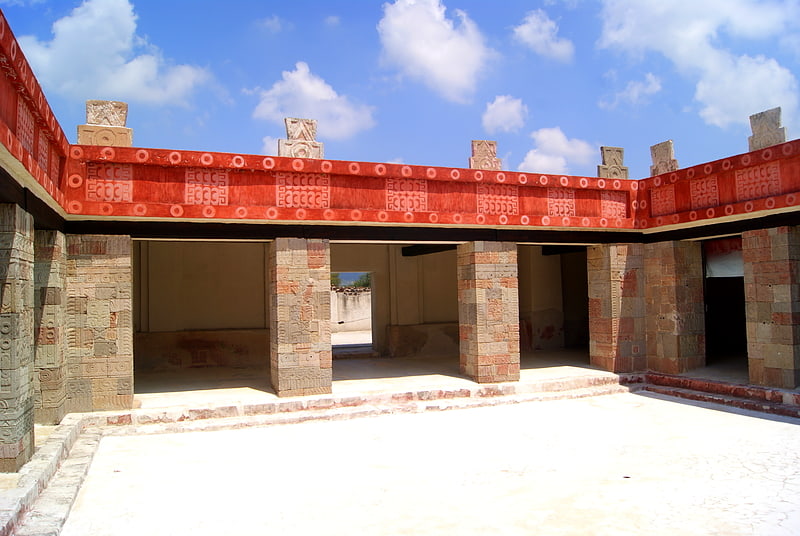
The Quetzalpapálotl complex are ruins located in Teotihuacán. The complex is best known for the Palace of Quetzalpapálotl and the stone reliefs in its courtyard. Adjacent structures house surviving murals. The main entrance faces the Avenue of the Dead and is southwest of the Pyramid of the Moon.[42]
Instituto Allende, San Miguel de Allende

University in San Miguel de Allende, Mexico. The Instituto Allende is a visual arts school in San Miguel de Allende, Mexico. The institute provides a range of courses, and offers a BA in Visual Arts and an MA in Fine arts in association with the Universidad de Guanajuato. Its courses and degrees are recognized by most North American universities. It has been popular with American and Canadian students and artists since it opened in 1950, and the town now has a large expatriate community from the USA and Canada.[43]
Address: Ancha de San Antonio, 22, San Miguel de Allende
Monte Alban, Oaxaca
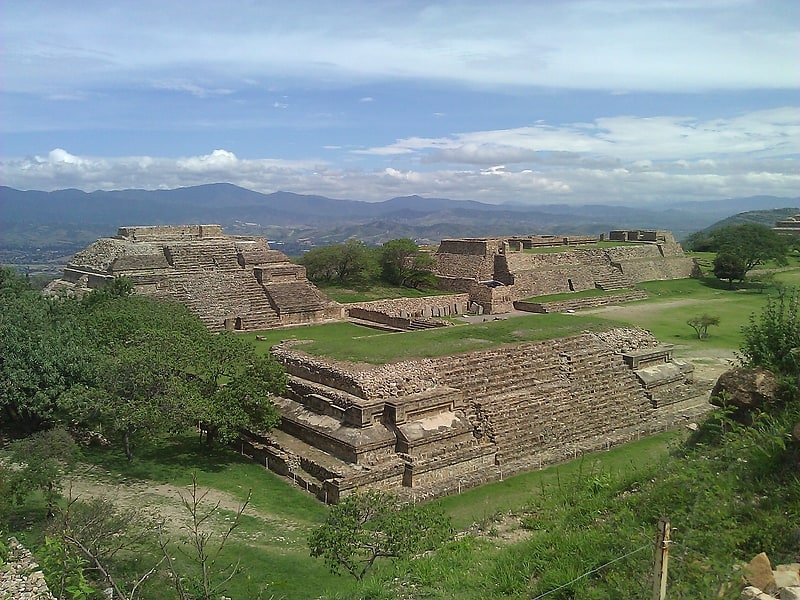
Also known as: Monte Albán
Monte Albán is a large pre-Columbian archaeological site in the Santa Cruz Xoxocotlán Municipality in the southern Mexican state of Oaxaca. The site is located on a low mountainous range rising above the plain in the central section of the Valley of Oaxaca, where the latter's northern Etla, eastern Tlacolula, and southern Zimatlán and Ocotlán branches meet. The present-day state capital Oaxaca City is located approximately 9 km east of Monte Albán.
The partially excavated civic ceremonial center of the Monte Albán site is situated atop an artificially leveled ridge. It has an elevation of about 1,940 m (6,400 ft) above mean sea level and rises some 400 m (1,300 ft) from the valley floor, in an easily defensible location. In addition to the monumental core, the site is characterized by several hundred artificial terraces, and a dozen clusters of mounded architecture covering the entire ridgeline and surrounding flanks. The archaeological ruins on the nearby Atzompa and El Gallo hills to the north are traditionally considered to be an integral part of the ancient city as well.
Besides being one of the earliest cities of Mesoamerica, Monte Albán was important for nearly one thousand years as the pre-eminent Zapotec socio-political and economic center. Founded toward the end of the Middle Formative period at around 500 BC, by the Terminal Formative (c. 100 BC – AD 200) Monte Albán had become the capital of a large-scale expansionist polity that dominated much of the Oaxacan highlands and interacted with other Mesoamerican regional states, such as Teotihuacan to the north (Paddock 1983; Marcus 1983). The city lost its political pre-eminence by the end of the Late Classic (c. AD 500–750), and soon thereafter was largely abandoned. Small-scale reoccupation, opportunistic reuse of earlier structures and tombs, and ritual visitations marked the archaeological history of the site into the Colonial period.
The etymology of the site's present-day name is unclear. Tentative suggestions regarding its origin range from a presumed corruption of a native Zapotec name to a colonial-era reference to a Spanish soldier by the name Montalbán or to the Alban Hills of Italy. The ancient Zapotec name of the city is not known, as abandonment occurred centuries before the writing of the earliest available ethnohistorical sources.[44]
Mercado Ignacio Ramirez, San Miguel de Allende
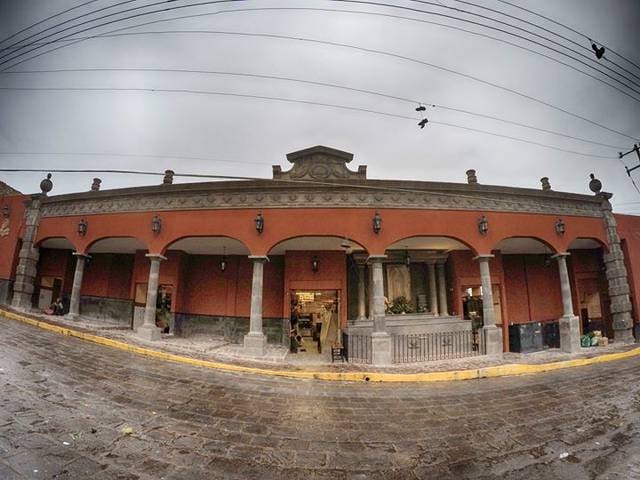
Shopping, Farmer's market, Market
Palace of Cortés, Cuernavaca
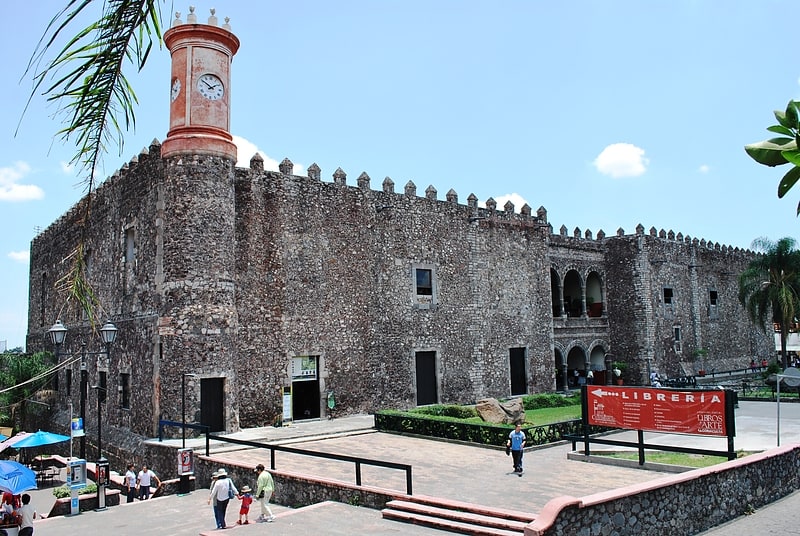
Also known as: Palacio de Cortés
Famous residence-turned-museum. The Palace of Cortés in Cuernavaca, Mexico, built between 1523–1528, is the oldest conserved colonial-era civil structure in the continental Americas. The architecture is a blend between Gothic and Mudéjar, typical of the early 16th century colonial architecture. The building began as a fortified residence for conqueror Hernán Cortés and his aristocratic second wife, Doña Juana Zúñiga. It was built in 1526, over a Tlahuica Aztec tribute collection center, which was destroyed by the Spanish during the Conquest. Cortés replaced it with a personal residence to assert authority over the newly conquered peoples. As Cortés's residence, it reached its height in the 1530s, but the family eventually abandoned it due to on-going legal troubles. In the 18th century, colonial authorities had the structure renovated and used it as a barracks and jail. During the Mexican War of Independence, it held prisoners such as José María Morelos y Pavón. After the war, it became the seat of government for the state of Morelos until the late 20th century, when the state government moved out and the structure was renovated and converted into the current Museo Regional Cuauhnahuac, or regional museum, with exhibits on the history of Morelos.[45]
Address: Av. Francisco Leyva, 62000 Cuernavaca